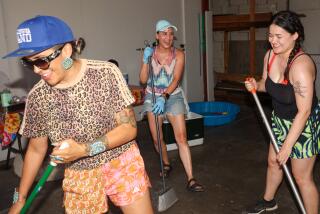‘Little India’ : Enterprising Immigrant Merchants Adding Spice to Artesia’s Main Street
Taped in the corner of a display case at Patel Bros. grocery in Artesia is a photograph of a typically American scene: Owner Ravi Merchant, flanked by family and a handful of smiling city dignitaries, is struggling to snip a long strand of ribbon with oversized scissors.
“That was a proud, proud moment,” Merchant recalled of the ceremony last June marking the opening of his import market, which specializes in spices and foods from India.
Such scenes are repeated almost weekly as stores selling Indian sweets, appliances, clothing, groceries and jewelry open their doors along Pioneer Boulevard, Artesia’s main street. Merchant is among a growing number of Indians who are turning a four-block stretch of downtown Artesia that some residents now call “Little India” into one of the nation’s largest Indian business districts.
“It took me five years to get a visa to come here,” said Merchant, who at 38 is the youngest of 12 children. Most of his family still lives in India, a hardship, he said, for him and his wife. “But to gain something,” he added philosophically, “you have to lose something. There is great opportunity here.”
Enterprising Indian merchants, some of whom were operating elsewhere in the United States, have seized the opportunity, giving a new spice to the small, middle-class city of 14,400. In the process, they have begun to revitalize an aging business district, according to city officials--and, inevitably, have ruffled some local feathers.
Artesia lies within minutes of 10,000 to 12,000 Indian emigres who have settled in the suburbs straddling the Los Angeles-Orange county line over the last two decades. Indian businessmen spotted the demand and began setting up shops in Artesia in the late 1970s. It was easy for Indians to locate in the city’s slumping business district--a victim of regional shopping malls and changing times. Leases were cheap and available.
Today, Indians come from as far away as the San Joaquin Valley, the Bay Area and even Arizona to shop. “One family comes here every 15 days from Phoenix,” Merchant said, “and spends $300 on rice, spices and oils.”
Only Jackson Heights in Queens and Chicago’s Devon Street have more native stores and restaurants, according to a spokesman at the Indian Embassy in Washington.
“On the West Coast, Artesia is the Indian shopping district,” said Rajen S. Anand, president of the Federation of Indian Assns. of Southern California. He said Artesia has become the “hub of the Indian community,” which he estimates numbers close to 35,000 in a three-county area, stretching from West Los Angeles to Riverside to Mission Viejo.
About 60,000 Indians lived in California at the time of the 1980 Census, and the amount of legal and illegal immigration has undoubtedly grown. Last year, the Immigration and Naturalization Service reported that Indians were the second-largest non-Latino group coming illegally across the Mexican border. And the number of visas to Indians climbed from 15,344 in 1977 to a record high 22,033 in 1984, according to the State Department.
In Artesia, nearly two dozen businesses are now owned or operated by Indians, many of them from the area around Bombay in western India. Most live in southeast Los Angeles or across the county line in La Palma, Stanton and West Anaheim.
Most are clustered along Pioneer Boulevard, a four-lane thoroughfare that slices north-south through Artesia, especially between 183rd and 187th streets. Despite the influx of Indian shopkeepers, Pioneer’s appearance has changed little in recent years. The one- and two-story buildings look much the way they did when they were rebuilt after the 1933 Long Beach earthquake.
The city shows few outward signs of a demographic shift. Signs above Indian businesses are in English. Indian customers, for the most part, wear Western garb. And a small but growing number of Americans frequent the Indian shops.
“You can’t beat the prices for material,” said Molly Reen, a Lakewood housewife and dressmaker who stops frequently on Pioneer to buy imported Indian cloth. She had just purchased four eggshell-colored silk saris and explained, “My daughter is getting married in June, and I wanted something soft and colorful for the bridesmaids’ dresses.”
But not everybody has rolled out the welcome mat for the Indian merchants.
Some longtime Artesia store owners resent the fact that Indian merchants have chosen, by and large, not to join the Chamber of Commerce. Others complain that landlords prefer leasing to Indians because they are willing to pay more.
Established merchants, some of whom have operated along Pioneer Boulevard for half a century, complain that parking is now at a premium, particularly on weekends. The crowds, some local businessmen say, discourage customers from frequenting their stores.
Some Feel Uncomfortable
“It’s like Bombay down there on some Saturdays,” said Don Wright, owner of AA Aadamson Jewelry in neighboring Cerritos. “Some people don’t want to shop on Pioneer anymore. They feel uncomfortable.”
Tired of “hassling” with the Indians, Gerald Herrema last year closed the coffee shop that his family had run in Artesia Plaza for 26 years and moved to the San Joaquin Valley. Hank’s Coffee Shop had been a gathering place for local officials, shop owners and the dairy farmers who once ruled this region, where most mornings it was difficult to find a seat at the counter or an empty booth.
“The Indians would come, park and spend the whole day here,” said Herrema, who now operates a small motel west of Modesto. “There was no parking. . . . Some of the Indians would leave their trash and dirty diapers in the lot. It was a mess.”
To top it off, he said, the landlord bumped the lease $400 a month. “He knew full well we wouldn’t pay for it,” Herrema said. “But he had a half dozen Indians just waiting to sign on the dotted line.”
Harold Campbell, Artesia’s acting city manager, said such talk is sour grapes. In a city where roughly 42% of its $2-million general fund comes from sales tax revenues, Campbell said Indian merchants are luring much-needed business to Artesia.
Stores Might Be Empty
“If the (Indian stores) weren’t there, what would be?” Campbell asked. “Chances are those stores might be vacant and that doesn’t do anybody any good. The landlord loses money. The city loses money. And the city’s reputation as a good place to invest and shop goes to seed.”
Indian merchants, like sari shop owner Dipak Malani, contend that they do not compete with established businesses because the clientele is different.
“We’re not selling Pierre Cardin shirts or Calvin Klein jeans,” said Malani, who with his brother operates three Indian clothing outlets. “How could anybody be upset with us?”
When Herrema closed his restaurant, Malani quickly picked up the lease, knocked out a few walls, and started selling brightly colored saris. Not content with selling clothing, Malani has purchased one of Artesia’s oldest buildings, the former First National Bank of Artesia, built in the 1920s, for the site of a restaurant.
“This area is on the verge of a big boom,” said Malani, 29, who lives in Cerritos and often returns to India on buying trips. “I want to be part of that.”
Many Professionals
In the 1960s and early 1970s, most of the Indians coming to Southern California were either students or professionals, such as physicians and engineers, according to Rajen, president of the Indian federation and chairman of the Department of Anatomy and Physiology at California State University, Long Beach. He estimated that 250 Indian doctors now work in southeast Los Angeles County and western Orange County.
A large number of Indian engineers and technicians moved to the area to work in Norwalk at Bechtel Corp., the worldwide construction company that built India’s first nuclear power plant in the early 1970s.
A second, and markedly different, group of Indian emigrants began coming to the Southland in the late 1970s. These were mostly the brothers, sisters and other relatives of the professionals who had moved here earlier, said Rajen, who left his country in 1963 to become a student at the University of California, Davis.
“They (the relatives) are the ones opening the shops and the restaurants, forming the business class that is servicing our growing community,” he said.
Moni Syal, who came to Artesia via London, bet his last $500 that he could do for spicy Indian food what his idol, McDonald’s founder Ray Kroc, did for hamburgers. An accountant by trade, he moved to Los Angeles in 1979 and worked briefly for the hamburger chain as a bookkeeper.
Opens Tiny Eatery
With his savings, he opened a tiny eatery in Norwalk in 1981, the “first Indian fast-food joint in California,” he said. It was quickly overrun with customers who flocked to take out curry chicken and vegetable-filled pastry shells known as somasas. A year later he moved to larger quarters in Artesia Plaza and plans, by summer, to open in Cerritos a second branch of his Reena Samosa Center, named for a type of pastry.
“It was time to bring Indian food to the masses,” Syal said, trying to be heard over the high-pitched sitar music blaring from a tape machine in his restaurant. He said too many Indian restaurants in this country are “fine dining houses, with white tablecloths and expensive menus.”
Sari shop owner Malani is typical of Indians setting up shop in Artesia. He is young, educated and aggressive. And he shares a belief held by many of his countrymen who move here: “There is no place like America to make a buck.”
Born in India, he moved to London when he was 19 and eventually became an insurance agent. But the chance to come to the United States and launch a business with his brother was too tempting. In the spring of 1983 he was granted a visa and by the fall he had opened his first Artesia store, Sari Niketan, the House of Saris.
“I might still be in London, one of hundreds of insurance salesmen, wearing collared shirts and fine tailored suits and collecting a 3% raise every year. But that’s not me. I’d rather work 20 hours a day for myself. . . .
“This way I control my own destiny,” said Malani, who, like many immigrants, hopes to return to his homeland after he makes his fortune in America.
More to Read
Sign up for Essential California
The most important California stories and recommendations in your inbox every morning.
You may occasionally receive promotional content from the Los Angeles Times.









